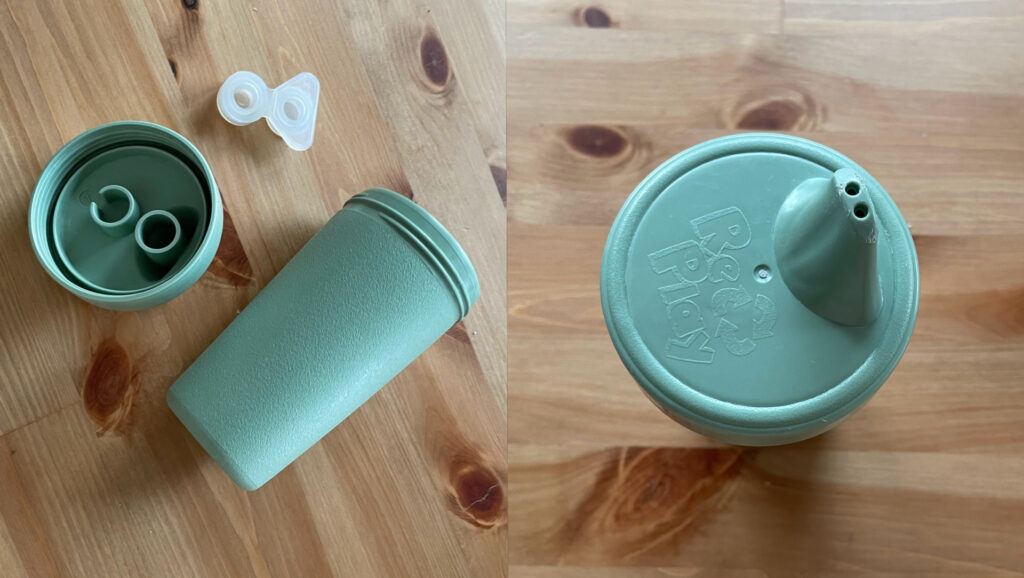This product was purchased in 2022. These cups are a three-piece set that includes a plastic lid with spout, the cup, and a silicone valve which fits on the underside of the lid. Silicone can test positive for very trace cadmium via XRF. These cups are very convenient for kids, resistant to shattering, and difficult to spill. They are made from recycled milk jugs in the United States.
How do you think this cup ranked using XRF?

Reading on the Plastic Cup:
| Element of Interest | Parts per million (ppm) | Error Range |
|---|---|---|
| None Detected | ||
| Other Elements | ||
| Chromium (Cr) | 6,284 | +/- 69 |
| Nickel (Ni)* | 10 | +/- 5 |
| Zinc (Zn) | 215 | +/- 6 |
| Titanium (Ti) | 6,872 | +/- 132 |
| Iron (Fe) | 103 | +/- 11 |
Reading on the Plastic Lid:
| Element of Interest | Parts per million (ppm) | Error Range |
|---|---|---|
| None Detected | ||
| Other Elements | ||
| Chromium (Cr) | 3,116 | +/- 48 |
| Nickel (Ni) | 18 | +/- 4 |
| Zinc (Zn) | 100 | +/- 4 |
| Titanium (Ti) | 3,855 | +/- 110 |
| Iron (Fe) | 72 | +/- 9 |
Reading on the Silicone Valve:
| Element of Interest | Parts per million (ppm) | Error Range |
|---|---|---|
| None Detected | ||
| Other Elements | ||
| Barium (Ba) | 314 | +/- 73 |
| Nickel (Ni) | 21 | +/- 7 |
| Zinc (Zn) | 109 | +/- 6 |
| Iron (Fe) | 39 | +/- 13 |
The sample was tested in consumer goods TestAll mode using a Niton XL3t 700S for 60 seconds. Results are rounded to the nearest whole number.
Test Summary:
The product is non-detect for elements of interest.
The silicone valve is non-detect for trace cadmium, which is excellent. It is common for trace cadmium to be detected in silicone products.
We think this is a great product that works as advertised.
We Prefer:
We like stainless steel or plastic cups for children when they are too young to use breakable glass bottles. We do not recommend double walled stainless steel bottles which can be manufactured with lead solder at the base of the unit. Sometimes these surfaces are exposed and sometimes they are hidden with a metal cap or sticker.
If sippy cups contain silicone parts that make direct contact with liquids or mouths we try to test these pieces for cadmium before use but we don’t always get around to doing it. This matter is low on our priority list. The levels of cadmium detected are extremely trace and below any cadmium limit for kid’s products that we are aware of so families should decide what works best for them.
We recommend avoiding vintage ceramic or painted glass cups, or older plastic cups, which can contain high levels of lead or BPA.
When possible, we recommend that all items used by children in the kitchen be lead free, with the exception of trace lead in products that are leach tested, preferably under 90 ppm lead on surface coatings, which is considered to be within legal safety limits for children’ s products.
Recommended Plastic Toddler Cups:
Disclosure: These are Amazon affiliate links for similar products. By shopping for any item on Amazon starting with our links, you help support our business and testing.
Below are kids’ cups similar to the one we tested.
Re Play Made in USA 10 oz. No Spill Cups for Baby, Toddler & Child Feeding


Why we like it: These cups are made in the USA from recycled milk jugs. How wholesome is that?
Arrow Home Products Sip A Cup with Built in Straw, 10oz, 6pk – BPA-free Straw Cups for Kids

Why we like it: Here is another polypropylene plastic cup made in the USA.
Disclaimer: These items have not always been personally tested by us but are likely to be lead free or low lead and/or cadmium based on our research into the materials, discussions with manufacturers, and/or testing on similar products. We recommend items we would use ourselves.
We provide our XRF testing for general educational or informational purposes only to help consumers identify low lead and lead-free products. We hereby disclaim any and all warranties, expressed or implied, and assume no duty or responsibility with respect to how any person or entity chooses to use the information on this website.

